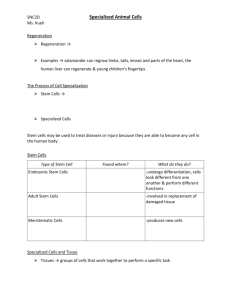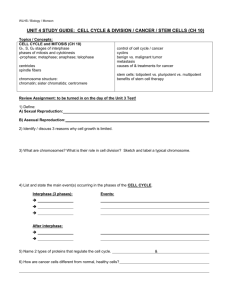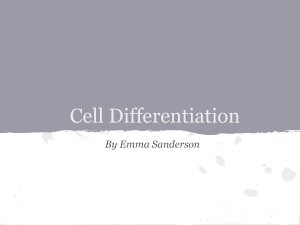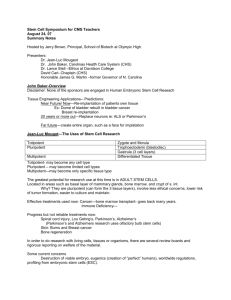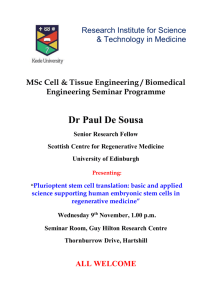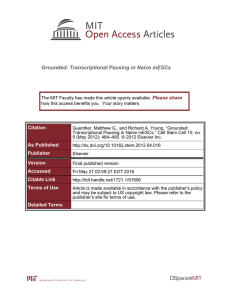Cell Specialization
advertisement
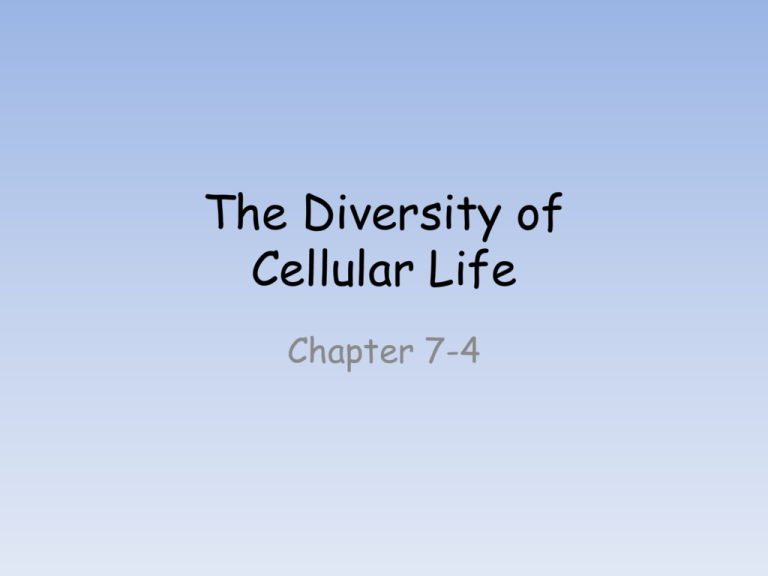
The Diversity of Cellular Life Chapter 7-4 I. Stem Cells A. Unspecialized cells with potential to differentiate(become specialized in structure and function). B. All the different types of tissue in your body (ex. Blood, nerve, skin, heart, liver, muscle, hair) were produced by mitosis from stem cells. II. Sources of Stem Cells A. Human embryos 1. Very controversial 2. Raises many moral and ethical questions B. Also found in: 1. Adult bone marrow 2. Umbilical cord blood cells. C. Recently scientists have been able to reverse the “clock” of skin cells and turn them into stem cells. D. One day we may be able to replace damaged tissue with stem cells from our own body! III. Stem Cells in Medicine A. Have the potential to: 1. Reverse brain and spinal injuries 2. Grow new liver tissue 3. Replace heart valves 4. Reverse effects of diabetes How do cells become Specialized? IV. It starts with fertilization of an egg cell by a sperm cell which creates a zygotye (The organisms first somatic cell). The zygote will: 1. Make IDENTICAL copies of itself by mitosis 2. Become a ball of TOTIPOTENT cells (stem cells that could separate from each other and produce a new organism. Identical twins, triplets, etc. 3. As more cells are produced by mitosis, they will form a BLASTOCYST, made of PLURIPOTENT stem cells. V. Pluripotent(stem)cells A. All have exactly the same DNA. B. Have the POTENTIAL to become ANY TYPE OF CELL in the organism!! C. Can NOT become a brand new fetus, like Totipotent cells can. D. Once pluripotent cells differentiate or specialize into a specific type of cell in the organism, they can not become any other cell. E. Can come from a blastocyst in an early developing fetus or umbilical cord blood or bone marrow cells after birth! Pluripotent cells have the potential to treat disorders/conditions such as: • • • • • • Spinal cord injuries Parkinson’s Diabetes Amputations Hemophilia Serious skin injuries VI. Cell Specialization =DIFFERENTIATION A. When a pluripotent cell turns into a specific type of cell in the organism, it has differentiated or specialized. B. Cells in multi-cellular organisms become SPECIALIZED by turning on genes needed for a particular cell’s function and turning off genes not necessary for that cell to function. Nerve cell Skin cell Muscle cell Stem or Pluripotent cell 1. Red blood cells transport O2, and CO2 a. Protein called hemoglobin carries the oxygen in the RBC. b. So, RBC’s need genetic info for making hemoglobin turned on. • A Day in the Life of a Red Blood Cell 2. Cells in the pancreas produce proteins that function as hormones and enzymes important in the breakdown of food. So, genes for making proteins like insulin need to be turned on. 3. Striated muscle cells allow movement So, Genes necessary for proteins that allow muscles to contract must be turned on. SPECIALIZED ANIMAL CELLS Muscle cells Cheek cells Red blood cells B. Specialized Plant Cells 1. Plants exchange carbon dioxide, oxygen, water vapor, and other gases through tiny openings called stomata on the undersides of leaves. 2. Highly specialized cells, known as guard cells, regulate this exchange. Specialized Plant cells Guard cells Xylem cells Pollen ATOMS ________ MOLECULES __________ ORGANELLES ___________ CELLS TISSUES ____________ ____________ Similar cells working together ORGAN ORGANS SYSTEMS ___________ __________ Different tissues working together Different organs working together ORGANISM ___________ Levels of Organiation that are LIVING/ALIVE 1. 2. 3. 4. 5. Cells Tissues Organs Organ Systems Organism http://www.youtube.com/watch?v =jF2iXpoG5j8 3 min https://www.youtube.com/watch? v=evH0I7Coc54
